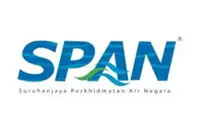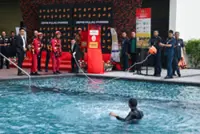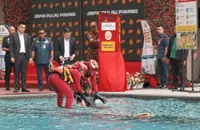Vital lesson: Basic Sports Training Skills Programme (KLAS Renang) swimming session for B40 children at Kepong branch of RNJ Swimming Academy. — Courtesy photo
CALLS for water safety awareness programmes and swimming lessons to be included in the school syllabus or as a co-curricular activity have grown louder recently.
This follows reports that about 500 people drown every year in Malaysia.
Acknowledging this, the Education Ministry said it would spearhead a reform agenda to strengthen the national education system.
Dive master and underwater camera operator Megat Samsul Kamal Mohamad Zamberi, 48, said the time was ripe for the ministry to look into this issue.
“In many countries, swimming classes have become part of the regular school curriculum.
“In Singapore, for example, swimming and water survival skills are taught to all primary school pupils as part of their physical education (PE) lessons.
“Locally, such programmes are only available in selected national schools.
“Ideally, this basic survival skill should be made available to all children,” he added.
The father of four boys aged seven to 14, takes it upon himself to teach his sons to swim.
Another concerned parent is Elisa Leong, 40, who has two boys aged 12 and 10.
Leong, a former national swimmer who is now a swimming coach, enrolled her sons for swimming lessons before they turned five.
She said many people mistakenly believed that swimming or water safety only applied at swimming pools.
“One has to remember that water is a big part of our lives.
“At home there are washing pails, bathtubs and inflatable pools where young children are at risk of drowning.
“Let’s not forget when people travel, they tend to go to beaches, rivers, lakes and hotel pools.
“All these places are where drowning usually occurs.
“It is important that water safety awareness or basic swimming skills are taught to schoolchildren,” she added. Inaccessible public pools
Leong said access to swimming pools could be hampering the introduction of this important life skill at schools.
“Not many people have access to swimming pools, unless they are club members or live in a condominium.
“Those living in public housing, landed property and rural areas would have little exposure,” she said.
“If more public exposure is to be given to water safety awareness, it has to start with the easy availability of public swimming pools.”
She called on local authorities to look into the maintenance of their public swimming pools so that the facility would be accessible to the public.
“Some public swimming pools in Kuala Lumpur, Putrajaya and Klang have been closed to the public – some for over a year –due to maintenance issues,” added Leong.
Malaysia Swimming Federation secretary-general Andy Low, who is in his early 60s, said upkeep of public pools was important as these facilities could be utilised by schools to teach the life-saving skill.
“When I was a member of my school’s swimming club, we learned how to swim and trained at the public swimming pool at Paroi in Seremban, Negri Sembilan,” he said.
At most public swimming pools, he said, there would be students from at least six or seven schools making use of the facility for either basic swimming lessons or water safety courses.
But for this to happen, Low said clear direction was needed.
These included application procedures by the respective schools for pool usage, funding for instructors and rental fees as well as frequency and duration of sessions allowed per school, added Low.
“Shoplot pools such as those operated by private swimming schools and mobile pools, which can be set up and dismantled according to programme duration, could be considered.
“It would be ideal if qualified volunteer instructors could be roped in to teach for a minimal fee to cover meals and transport,” he said, adding that retirees from local councils and the fire brigade who had experience in water rescue, could also be considered.
“Even university students who could use the volunteer hours clocked as credit points.” Lessons and programmes
Malaysia Aquatic Rescue Association president Dollah Said, 62, said in 2018, then Education Minister Dr Maszlee Malik had said swimming would be introduced as a co-curricular activity and it would take off with schools located near public swimming pools.
“Many people saw it as good news,” said Dollah, who is also a former exco member of Lifesaving Society Malaysia.
“But no more was heard of the programme after Maszlee resigned in 2020.”
He said the Water Activities Safety Council (MKAA) was formed in 2016, parked under Housing and Local Government Ministry (KPKT), following drowning incidents involving tourists in Johor, Sabah, Sarawak and Langkawi, Kedah.
KPKT’s eSERANTA website stated that in the MKAA draft plan, among the strategies to be carried out was the compilation of a data bank consisting of drowning-related statistics.
“From the data, the council members were supposed to decide on which states to target so that attention can be given first to the most at-risk groups,” said Dollah.
He added that there were also programmes to teach basic swimming and water rescue to school and university students with the Fire and Rescue Department as implementing agency and Education Ministry and KPKT as strategic partners.
The programme would also involve private companies coming in as sponsors.
“What we need now is a clear direction for nationwide implementation,” he said.
Lifesaving Society past president Geh Thuan Tek, 61, who has been teaching survival swimming, life saving, water safety and basic rescue since 1979, is a member of MKAA.
He recalled that one of the activities the council had first organised was a survival swimming, water safety and basic rescue course for 33 teachers from all over Malaysia in 2021.
The five-day course was at Kem Tekali in Hulu Langat, Selangor, after the Covid-19 movement control order was lifted.
The teachers came from Kedah, Penang, Melaka, Johor, Sarawak and the Federal Territories of Putrajaya, Kuala Lumpur and Labuan.
There were three teachers from each state, and they were briefed on dry rescue.
“The idea was that they would go back to their own states and promote the programme,” said Geh.
The latest update received from one teacher in Kuching, Sarawak, was that she had organised a one-day programme for 50 special needs children at the Aquatic Centre, Kuching Sports Complex last month.
Attended by parents and school staff, the objective was to build water confidence and teach basic swimming skills.
Six other facilitators from Sarawak Co-curricular Centre were also present.
Geh, who is also on Royal Life Saving Society Commonwealth board of trustees and is a senior grade-one assessor for International Certification in Lifesaving and Lifeguarding, said MKAA continued to remain active with the fire department in carrying out programmes involving sailors, swimming clubs, residents associations and schools.
The last major event, a drowning prevention forum and workshop involving 300 participants from 30 Asean countries including Malaysia, took place in May 2023.
Malaysia Swimmers and Swimming Coaches Association vice-president Raymond Ho, 34, said although there was no lack of fresh talent in terms of competitive swimmers at school level, not all school swimming clubs could cater to beginners.
For this group, the most popular option was to take private swimming lessons.
However, the cost could be prohibitive to those from the lower income group.
“The Basic Sports Training Skills Programme (KLAS Renang) to provide swimming lessons for B40 children by Youth and Sports Ministry is meant to address this,” he said.
Ho’s company RNJ Swimming Academy is working with the ministry to deliver KLAS Renang lessons.
With a RM2mil grant from the ministry, 6,760 children aged six to 12 have been taught at 55 locations in Kelantan (Kota Baru, Tanah Merah and Bachok), Terengganu (Kuala Terengganu), Kuala Lumpur, Sabah and Sarawak.
Each participant received six free lessons, a swimsuit and a pair of goggles sponsored by a sporting goods retailer.
A majority of the lessons took place at the academy’s 70 branches.
“To ascertain eligibility, the parents were required to declare their income and furnish their payslips and bank statements at the registration stage,” said Ho, who hopes KLAS Renang will continue after Chinese New Year.
An Education Department spokesperson, when contacted on the introduction of swimming lessons in school, said it was waiting for further action from the Education Ministry.
Kuala Lumpur Fire and Rescue Department head of public safety awareness programme Roshdi Fitri Roslan said schools wanting to organise water safety awareness talks and training could seek its help.
Headmasters are advised to contact the nearest station for enquiries.














